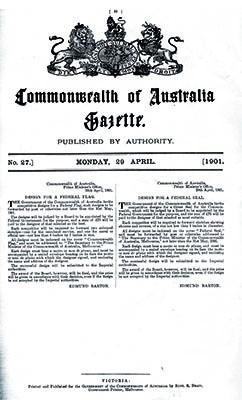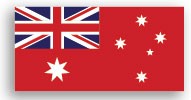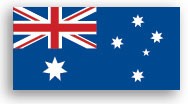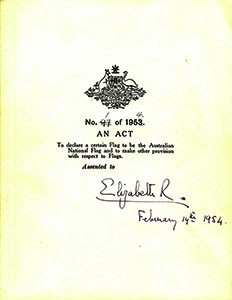A flag competition
In 1900, with federation looming, the search for a national flag began. A Melbourne journal, the Review of Reviews for Australasia, launched a competition in November 1900, offering a first prize of £50. The journal suggested that entries in the flag competition incorporate both the Union Jack and the Southern Cross.
Upon federation in 1901, the Commonwealth Government also announced it would run a flag competition, and the Review of Reviews agreed to combine its entries with those submitted to the government competition. The prize money (£75 from the Review of Reviews and £75 from the Government) was boosted to £200 by a donation from the Havelock Tobacco Company.

The conditions of the government competition were set out in the Commonwealth of Australia Gazette of 29 April 1901. The notice also stated that the successful design would be submitted to the imperial authorities for approval.

REPRODUCED COURTESY OF THE NATIONAL ARCHIVES OF AUSTRALIA
More than 30,000 entries
In all, 32,823 entries were received from all over the world and from people of all ages and backgrounds, even an unnamed state Governor. The size of the entries also varied, from two postage-stamp-sized ones (which were disqualified for being too small) to a pair of entries using about 60 square metres of bunting.
The majority of the designs contained the Union Jack and Southern Cross but native animals were also popular. Among the more quirky designs were a kangaroo leaping through the constellation of the Southern Cross, a scene depicting native animals playing cricket with a winged cricket ball, a six-tailed kangaroo representing the six Australian states, and a kangaroo aiming a gun at the Southern Cross.
Judging the designs
All the designs were displayed at the Exhibition Building in Melbourne, where the first Commonwealth Parliament had opened. The judges spent six days viewing the entries, looking for a design that incorporated the Union Jack, the Southern Cross, and a representation of the six states joined in federation.
The judging criteria included historical relevance, compliance with the conventions of heraldry, originality, utility, and the cost of manufacture. The judges also sought a design that would be acceptable to the British Admiralty.
Five winners found
The judges settled on five almost identical designs. The prize money of £200 was divided among the winners: Annie Dorrington from Perth, who became a quite well-known artist; Ivor Evans from Melbourne, a 14-year- old schoolboy whose father owned a flag-making business; Leslie Hawkins, a teenager from Leichhardt in New South Wales; Egbert Nuttall, from Prahran in Victoria; and William Stevens, First Officer in the Union Steamship Company of New Zealand.

THE COMPETITION WINNING DESIGN
The National flag flies
The Australian flag flew for the first time on 3 September 1901, the day on which Prime Minister the Right Hon Edmund Barton announced the competition winners. It was a large flag, 5.5 metres by 11 metres, and was flown over the dome of the Exhibition Building, where all the designs were on display. The Australian National Flag as we know it today is based on this design. The canton featured the Union Jack, underneath it was a six-pointed star representing the six states, while the five stars of the Southern Cross occupied the fly. The background was dark blue.
At first, this flag was known as the Commonwealth blue ensign; later it became the Australian National Flag. The Commonwealth red ensign, or merchant flag, was identical except that its background was red instead of blue.
Australian National Flag Day
To commemorate the day on which the Australian National Flag was first flown, 3 September of each year is officially recognised as Australian National Flag Day.

PHOTOGRAPH COURTESY OF THE NATIONAL AUSTRALIA DAY COUNCIL
Changes to the national flag
The design of the Southern Cross was simplified when the blue and red ensigns were gazetted in February 1903. The four main stars, which originally had different number of points to reflect their varying brilliance, all became seven‑pointed stars. The smallest star remained a five-pointed star.
In 1908, the six-pointed star representing the six states was replaced by a seven‑pointed star, the additional point representing the territories. At that time, Papua was the only territory of the Commonwealth, but the symbolism was intended to include any territories created in the future. The change was gazetted in December 1908.
Blue or red ensign?
For the next several decades there was confusion surrounding the use of the two Australian flags. At first, the blue ensign was intended for official and naval purposes only and the red ensign was to be used by the merchant fleet. However, the general public also began using the red ensign on land. The flag placed in the time capsule left by Antarctic explorer Sir Hubert Wilkins in 1939 was the red ensign.
The Union Jack also continued to be used widely in the community. For example, in 1931 it was draped over the coffin of one of Australia’s most famous soldiers, General Sir John Monash.
On 15 March 1941, Prime Minister the Right Hon Robert Menzies issued a press statement recommending the flying of the blue ensign as a national emblem on public buildings and schools and by private citizens, provided it was used with respect. The red ensign was to continue to be used by Australian merchant ships. On 24 February 1947, Prime Minister the Right Hon Ben Chifley expressed his support for this wider use of the blue ensign.
The Flags Act 1953 ended the confusion about which ensign to use.

THE AUSTRALIAN RED ENSIGN

THE AUSTRALIAN BLUE ENSIGN
The Flags Act 1953
In 1951 King George VI had endorsed the Australian Government’s recommendation to use the Commonwealth blue ensign as the Australian National Flag. The Flags Act 1953, passed by the Australian Parliament in December, proclaimed the Australian blue ensign as the national flag and the Australian red ensign as the flag for merchant ships registered in Australia. The Act was signed into law by Queen Elizabeth II on 14 February 1954, after she opened the Australian Parliament.
The Shipping Registration Act 1981 which came into operation on 26 January 1982 confirmed the Australian red ensign as the official flag to be flown by Australian-registered merchant ships.
Today, the Australian National Flag is a symbol of the entire nation. Australians also recognise other important flags that represent areas or groups within the nation, such as the state and territory flags, the Australian Aboriginal Flag, the Torres Strait Islander Flag, and the ensigns of the Australian Defence Force.
Protection for the Australian National Flag
On 24 March 1998, the Flags Amendment Bill became law. It amended the Flags Act 1953 to ensure that the Australian National Flag can only be changed with the agreement of the Australian people.
In the event that a poll is required, the existing design of the Australian National Flag must be one of the designs in any selection put to the people.

PHOTO COURTESY OF THE NATIONAL ARCHIVES OF AUSTRALIA: A1559, 1954/1
